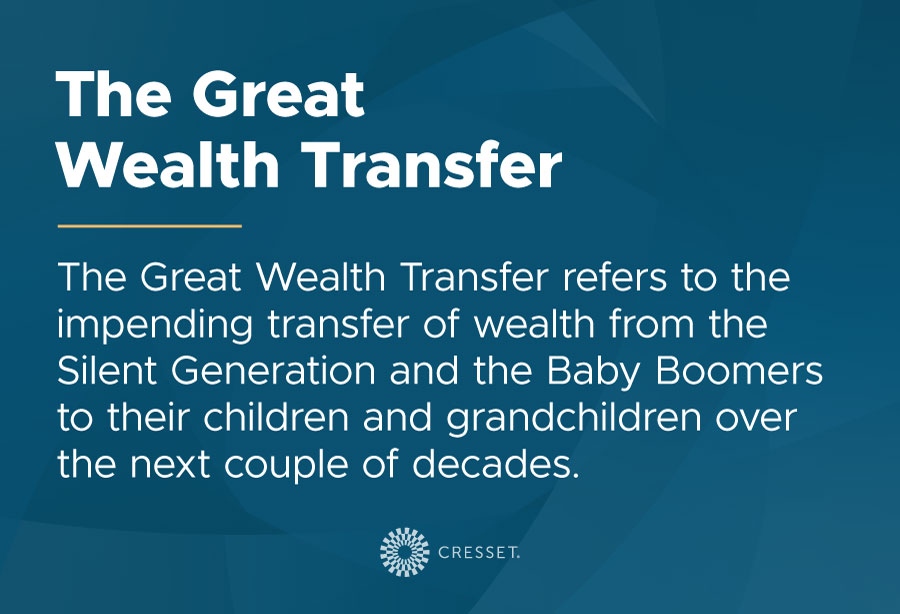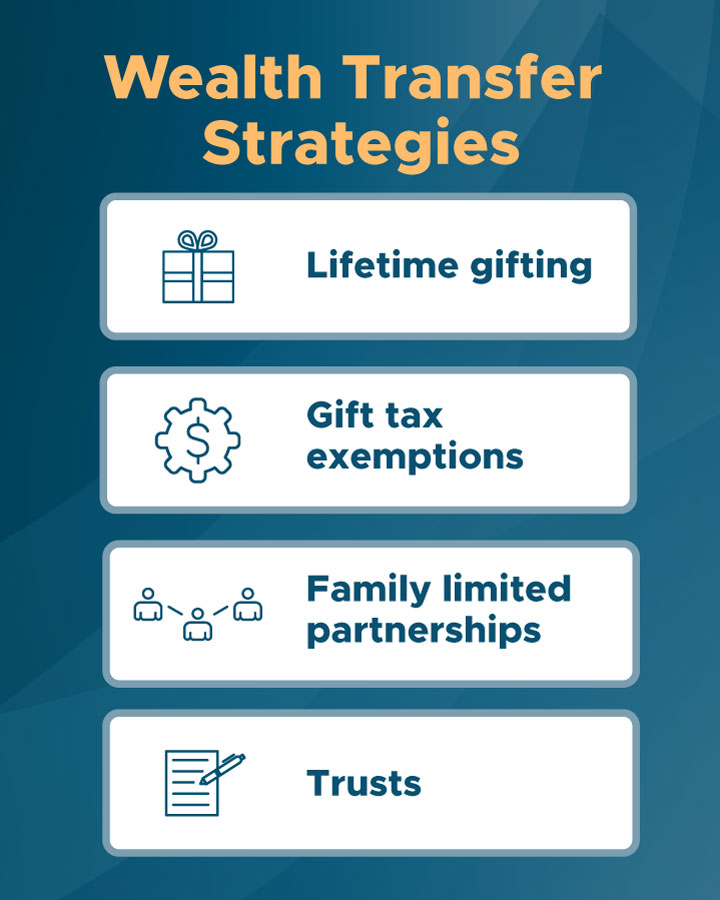Family Office Guide / Generational Wealth: A Guide to The Great Wealth Transfer
Knowledge Base
Knowledge Base
Table of Contents
Subscribe to Family Office Insights
By providing your email address, you consent to receive messages from Cresset regarding our services. View our Privacy Policy.
Related Topics
Generational Wealth: A Guide to The Great Wealth Transfer

By Anne Paape
Managing Director, Head of Wealth Strategy

By Anne Paape
Managing Director, Head of Wealth Strategy
10 minute read
Table of Contents
The world is on the brink of an unprecedented financial shift—The Great Wealth Transfer. Experts estimate that one-third of Americans expect to receive some inheritance, and that half of those wealth transfers will occur within the next ten years. That means that over the coming decades, trillions of dollars will pass from one generation to the next. For families, The Great Wealth Transfer represents an unparalleled opportunity to secure a legacy. However, doing so requires strategic planning.
In this guide, we will cover what The Great Wealth Transfer is, provide a comprehensive wealth transfer definition, and offer generational wealth transfer strategies to help you make the most of this important period. Having a forward-thinking plan ready in advance will help you and your family facilitate a tax-efficient wealth transfer so that more of your family’s wealth goes to the people and causes you care about.

What Is The Great Wealth Transfer?
The Great Wealth Transfer refers to the impending transfer of wealth from the Silent Generation and the Baby Boomers to their children and grandchildren over the next couple of decades. It is projected to be the largest intergenerational wealth transfer in history, with just over $84 trillion estimated to change hands over the next 25 years. While $12 trillion of that total is expected to be donated to charities, the rest will transfer to heirs.
Of course, not all of that $84 trillion will be in cash. Much of the inherited funds will be in the form of real estate, equities, and other forms of wealth. The impacts will be far-reaching. Experts anticipate that this unprecedented transfer will impact the global economy, philanthropic ventures, and financial markets. What that market impact will look like greatly depends on how the technology-conscious Millennials and members of Gen Z decide to invest.
What Is Generational Wealth Transfer?
Whether it is referred to as generational wealth transfer, family wealth transfer, or the intergenerational transfer of wealth, each phrase refers to the same thing: the process of passing wealth to the next generation. There are many ways to transfer wealth, and a strategic approach will help you do so without incurring significant tax burden.
Below, we’ll dive into the basics, starting with a definition of wealth transfer itself, before moving into a more detailed look at how to pass wealth to heirs using tax-efficient wealth transfer strategies.
Wealth Transfer Definition: Put simply, wealth transfer is the process of moving wealth—whether in the form of cash, assets, or real estate—from one owner to another. In the case of family wealth, this transfer is often from those of an older generation to their children or grandchildren. Of course, family wealth transfer can also refer to transferring funds to siblings, parents, spouses, or other family members.
How to Transfer Wealth to Family
There are many ways to move wealth from one party to another, and the decision of how to do so is both a personal and a strategic one. No one understands your family relationship dynamics or the needs of your heirs better than you and your family, but it is also important to be aware of how different wealth transfer strategies will support or conflict with your overall wealth plan.
Balancing the personal with the pragmatic can be challenging, so it is helpful to consult with a trusted advisor or wealth management team to determine what strategies will best support your family’s needs.
In the next section, we will cover some of the most popular and effective family wealth transfer strategies to give you a starting point as you begin your plan for generational wealth transfer.
Wealth Transfer Strategies
A tax-efficient wealth transfer plan will likely involve a combination of strategies. High- and ultra-high-net-worth families often have complicated finances, made all the more challenging by equally complex family dynamics.
Your wealth transfer plan will be unique to you and your family, which is why it is so important to work with a trusted team that understands and supports your family’s goals. They can recommend more common wealth transfer strategies, like establishing specific kinds of trusts, as well as the less common tactics, such as investing in Qualified Opportunity Zones to enhance the transfer of wealth.
Below, we have outlined some of the generational wealth transfer strategies that you may want to consider incorporating into your wealth transfer plan. There are two main ways of transferring wealth: either by leaving an inheritance that family members have access to after the grantor’s death, or by gifting funds or assets during one’s lifetime. Both methods come with distinct benefits and challenges. We will break down these broad categories into specific strategies so you can start to consider how you would like to structure your wealth transition plan.


Lifetime Gifting
When we think of generational wealth transfer, it is natural to primarily think of traditional inheritances. However, gifting during one’s lifetime is an increasingly popular, proactive solution that not only enables gifters to experience the joy of seeing their family wealth put to use, but also offers significant tax benefits. As of 2025, the annual gift tax exclusion is set at $19,000. This means that an individual can gift this amount to as many other individual people as they would like—such as children or grandchildren—over the course of a year without triggering tax liabilities.
Over time, these gifts can add up to a substantial amount of tax-free wealth being transferred. Lifetime gifting can also benefit children and grandchildren when they might need it most. These gifts can be allocated for specific expenses, such as supporting a downpayment on a house, furthering education, or planning a wedding.
Rather than expecting loved ones to wait until after they are gone, many wealthy parents and grandparents are instead choosing to provide ongoing support during their lifetimes. In addition to creating lasting memories through shared experiences like travel, families can also take advantage of tax-free opportunities such as funding 529 education savings accounts, paying tuition directly, or covering healthcare expenses. These strategies not only provide potential immediate benefits but also allow wealth to be transferred efficiently and meaningfully during one’s lifetime.
Regardless of how these lifetime gifts are used, they reduce the taxable estate that will be passed on after the grantor’s death. This means that more wealth is transferred to the family over time, and less is lost to taxes at the end of the grantor’s life.
Leveraging Gift Tax Exemptions
While we are on the subject of lifetime gifting, the federal gift tax exemption can be another effective tool for tax-free wealth transfer. As of 2025, the lifetime gift exemption is $13.99 million per individual. Since that is very likely to change to just $5 million on December 31, 2025, it is important to start preparing for this impending shift.
Let’s look at an example of how business owners can leverage gift tax exemption. A business owner could gift shares in their business to heirs using the lifetime exemption. Over time, the value of those shares could appreciate beyond the taxable estate, maximizing the gifter’s tax efficiency.
Family Limited Partnerships
Another method that helps maximize both gift and estate tax exemptions is to establish a family limited partnership (FLP). These legal structures enable families to pool their assets into a business or holding company which can then be used to transfer shares to heirs while retaining control over the assets.
There are two types of partners in this structure:
- General Partners are those who own the largest shares in the business and also have management responsibilities. Depending on the partnership agreement, general partners may take a management fee from the business’s profits.
- Limited Partners do not have management responsibilities. Instead, they purchase—or are given—shares in the business and receive dividends and interests, as well as profits as the business grows.
Often, parents serve as the general partners, which gives them decision-making authority over the FLP’s assets. Heirs may serve as limited partners, while their parents gradually transfer assets to their children through gifts or sales. This system gives parents control while teaching heirs responsibility as they become involved in the business. It also offers both gift and estate tax benefits.
FLP interests can be gifted tax-free up to the annual exclusion limit each year, which is currently set at $19,000. A benefit of gifting FLP shares, rather than just $19,000 in cash, is that the value of the shares is determined by their fair market value, which means they may be eligible for valuation discounts. If FLP shares are appraised at a discount, you may be able to gift more than $19,000 worth of underlying assets without exceeding the limit.
FLPs also offer potential estate tax advantages. If structured correctly, FLP shares that were gifted are not included in one’s taxable estate, so future returns are protected from estate taxes. When managed properly, FLPs can significantly grow generational wealth. However, managing FLPs can be both costly and complicated, so it is best to work with your wealth management team to decide whether an FLP is the right choice for you. If you do decide to go this route, continue to work with advisors during both the set-up and management phases.
Establishing Trusts
Trusts are among the most common vehicles for transferring wealth to the next generation, and for good reason. Trust options are versatile, so families can use them to specifically tailor their wealth transfer plan depending on their needs and goals.
The many kinds of trusts available fall into two main categories—revocable and irrevocable trusts:
- Revocable Trusts: Also known as “living trusts,” revocable trusts allow the grantor to make adjustments to the terms during their lifetime. These trusts offer more ongoing control than irrevocable trusts but less protection from creditors and estate taxes.
- Irrevocable Trusts: As their name suggests, irrevocable trusts cannot be altered once they are established. That means that the trust terms and beneficiaries cannot be modified or removed.
While the flexibility of revocable trusts is enticing, irrevocable trusts are worth considering for their ability to reduce tax impact on generational wealth transfer, as funds placed in an irrevocable trust are not subject to estate taxes upon the grantor’s death. An example of a valuable trust is an irrevocable life insurance trust, which removes the value of the death benefit from the taxable estate of the grantor.
While trusts are one of the most powerful tools for generational wealth transfer, the sheer amount of trust types available within the above umbrella categories is reason enough to work with advisors to determine which trust types might benefit your family the most.
Are You Ready For The Great Wealth Transfer?
Being prepared for The Great Wealth Transfer means more than just updating your will. In reality, it requires a comprehensive plan that involves tax-efficient strategies, legal protections, and clear communication with family members. If you are feeling uncertain about whether you are ready for this major financial shift, consider the following benchmarks. If you do not feel confident that they are in place, consult with your wealth management team to see how you can start to improve your plan now.
Comprehensive Asset Inventory
Updating one’s will is an important part of the intergenerational transfer of wealth. If there are assets that are solely in your name, such as properties, stocks, or more, be sure to include them in your will or allocate them to a trust.
Before you can create a detailed, tax-efficient wealth transfer plan, you’ll need a comprehensive list of assets that includes their values and ownership status. While this step may sound straightforward, for families with significant generational wealth, the process can be quite complicated. Your inventory should include financial accounts, real estate, business interests, insurance policies, and even intangible assets like intellectual property, if applicable. Your family wealth management team can help you put this list together.
A Defined Wealth Transfer Plan
A list of assets is important, but it will have no impact without a comprehensive, tax-efficient wealth transfer plan. The more thorough your plan, the less likely it is that there will be disputes later on.
The purpose of an estate plan is to give you control over how your assets are distributed while minimizing the effects of estate and gift taxes. Employing a combination of strategies will support your wealth goals and protect your family’s legacy.
Family Communication
Even the most thoughtful generational wealth transfer plans are incomplete without ongoing communication with your family in advance of the wealth transfer itself. Clear communication with family members is one of the most commonly overlooked components of a wealth transfer plan, and yet it can be the key to ensuring wealth is transferred successfully.
Conversations about inheritance can be hard. Not only can it feel awkward to discuss money, it can be painful to consider our own and our loved ones’ mortality. Still, these conversations are crucial, as is establishing a framework for open, ongoing communication. Successfully doing so will help to align family members on goals and values, which means that there will be no surprises—or hopefully disputes—when the wealth transfer does take place.
Business Succession Plan
This benchmark may not be applicable for all families, but for those that do own businesses, it is necessary to include succession planning into your wealth transfer plan. Continuity in the family business will help it retain its value and maintain smooth operations, even through a transfer of ownership. Work with your advisors to draft a detailed succession plan that outlines who will take over control of the business and when, as well as a buy-sell agreement or valuation strategy to facilitate the transfer.
A Professional Support System
Developing and implementing a wealth transfer plan is complicated, but there is no reason to do it alone. For families with substantial wealth, having the support of a team of professionals can make all the difference. The benefits of working with a trusted wealth management team make the associated costs well worth it.
Without the support of advisors, including estate planning attorneys, legal professionals, tax experts, and financial planners, you may not really be prepared to transfer wealth or for the many complications that can appear along the way. The right team can even help you face challenges like market volatility and turn them into transfer opportunities.
Of course, when it comes to wealth management, there are many options to choose from. Family offices—either single or multi-family—tend to include all of the professionals listed above in-house, making them a strong contender for supporting generational wealth transfer. Plus, the job of a family office is to understand your family’s finances and dynamics inside and out, so they can assist with developing wealth strategies and help foster communication, education, and dispute resolution amongst your family members.
If you can confidently say that you possess all of the above benchmarks, then you are well on your way to being prepared for The Great Wealth Transfer. Readiness is not static, however, and as regulations and familial relationships evolve, so too will your wealth transfer plan. Regularly revisit and update your plan, continue to engage with heirs, and heed the advice of your financial team over the coming years to achieve and maintain preparedness.
How To Start Your Wealth Transfer Planning & Strategy
If you are just beginning to develop your family wealth transfer plan, there is no need to panic. The best time to begin planning for the intergenerational transfer of wealth is as soon as you can, and starting now will put you in a better position than many. Take the following steps to initiate the process.


Establish Your Goals
Before you dive into the details of creating your wealth transfer plan, consider what your overall goals are. You can start more generally than you might expect—in fact, it is worth examining your personal and family values, and letting those guide you as you establish your goals. The more clearly you understand your own priorities, the easier it will be to communicate them to your family and wealth management team.
Assemble Your Team
Beyond setting goals, perhaps the most important early step in intergenerational wealth transfer is making sure you have the right team to guide you through the process and implement your plan. While there are many financial management structures to choose from, we would be remiss if we did not recommend the multi-family office for integrated, tailored wealth management services.
At Cresset, our multi-family office provides comprehensive, goals-based wealth management that prioritizes generational wealth transfer. We’ll support you through every step of the process, including providing family education and governance to help prepare the next generation for the responsibility of inheriting wealth. We can help you synthesize your goals and turn them into a comprehensive wealth plan that integrates your investment plan with your generational wealth transfer strategy to grow your wealth and your family’s legacy.
Inventory Your Assets
Before you can allocate your assets, you need to know what you have, what the value of the assets are, and whose name they are in. Perhaps you have already placed some assets in a trust, or perhaps you always meant to, but have not done so yet. Seeing a clear picture of your family wealth will help you understand your wealth transfer options and make decisions about how—and to whom—assets will be transferred.
Start Your Plan Today
Preparing yourself and your family for the great transfer of wealth may feel overwhelming, or it may feel like you do not need to worry about wealth transfer for many years. However, starting your plan early not only means you’ll be prepared in the event of an unexpected emergency, it also means you can take advantage of lifetime gifting strategies. The longer you use annual gift exemptions, the more beneficial they are for your heirs. And, as the sunset of the current lifetime gift exemption approaches, it may be wise to take full advantage before the end of 2025.
If you are interested in starting your wealth transfer plan or enhancing the plan you currently have, schedule a call with one of our founders today. At Cresset, we are ready to learn about your family’s long-term goals and start incorporating them into a comprehensive wealth plan that focuses on what matters most—taking care of your loved ones.
Subscribe to Family Office Insights
By providing your email address, you consent to receive messages from Cresset regarding our services. View our Privacy Policy.
